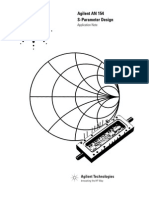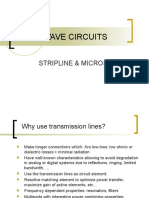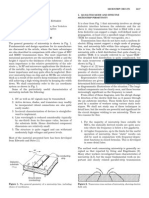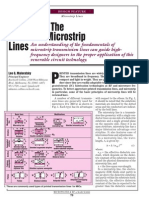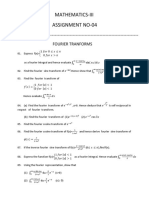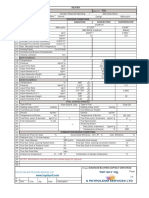Design of Stripline Structure For Electromagnetic Characterization at Microwave Frequency
Uploaded by
Paul ShineDesign of Stripline Structure For Electromagnetic Characterization at Microwave Frequency
Uploaded by
Paul Shine1036
PIERS Proceedings, Moscow, Russia, August 1923, 2012
Design of Stripline Structure for Electromagnetic Characterization at Microwave Frequency
Ellen Yoshie Sudo Lutif1, 2 , Anderson Kenji Hirata2 , Alberto Jos de Faro Orlando1 , and Antonio Carlos da Cunha Migliano1, 2 e
1
Aerospace Technological Institute (ITA), CTA, Brazil 2 Institute of Advanced Studies (IEAv), CTA, Brazil
Abstract A comprehensive approach to the design of a stripline for EMC testing is given in
this paper. The authors attention has been focused on the design items that are most crucial by the achievement of satisfactory value of the VSWR and impedance. The characteristic impedance of the stripline test section should be smoothly matched with the feed and terminations points in order to minimize the standing waves. Thereby, the most critical parameters that directly determine the physical design of the stripline are impedance matching at the feed port (S11 parameter) and transmission between two ports (S21 parameter). An analysis can be performed for the stripline conguration using a vector network analyzer. A measurement of the reection from transmission through a material along with knowledge of its physical dimensions provides the information to characterize electromagnetic waves at microwave frequencies range. 1. INTRODUCTION
Typical striplines are constructed to have an impedance of either 50 or 90 . The ratio between the width of the active conductor and the height of the active conductor and the height of the active conductor above the ground plane determines the characteristic impedance. The design given in this paper is focused on the 50 stripline. Today in communication systems the use of magnetic and dielectric materials exceeds the usual elds of application (randomes, antennae, microwave circuits, . . . ). New components are developed to meet the demand of leading areas. This is the case for materials absorbing the electromagnetic energy, which are used for microwave electromagnetic compatibility (EMC). A vector analyzer is a versatile measurement system, which comprises of a two or four channels for microwave receiver designed to process the magnitude and phase of transmitted and reected waves of the network. It directly displays the S-parameters of passive and active networks at the desired frequency range. With advancement of technology, VNA are available now with full range of parameters to be measured like S-parameters in magnitude (dB)/phase form, real/imaginary form, as well as in the linear form, VSWR, Group delay, impedance, etc.. When dealing with vector measurement quantities, such as complex reection and transmission coecients (i.e., S-parameters) in RF and microwave metrology, several important factors need to be considered such as the expression form of the complex quantities (either in the real and imaginary components or magnitude and phase components) and correlation between these components [1]. Earlier the magnitude and phase form of complex S-parameter was selected as the measurand. The uncertainties in the magnitude and phase form of the VNA measurements have been studied and reported earlier [2]. The mathematical model for determining the measurement uncertainty depends on the type of measurand. The studies showed an ambiguity in the phase measurement, where phase depends highly on the structure and application of device under test (DUT) as well as the operating frequency. To avoid the problems during the statistical analysis of complex quantities in the magnitude/phase form, the real and imaginary form has been chosen to analyze the complex quantities. In this form, the real and imaginary components of complex S-parameter are correlated, so their covariance also contributes to the uncertainty.
2. THEORY 2.1. Stripline Design
A stripline consists of upper and down grounding plates, and the central conductor. Between the grounding plates and the central conductor is air or dielectric materials. The fundamental propagation mode for a stripline is TEM. For the TEM wave propagation in a stripline, the phase velocity is: c vp = (1) r
Progress In Electromagnetics Research Symposium Proceedings, Moscow, Russia, August 1923, 2012 1037
where r is the dielectric constant of the lling medium and c is the speed of light. If the central conductor is narrow, the interference between the elds at the two edges cannot be neglected. We may take the central conductor as a cylinder by introducing equivalent diameter as shown in the equation above: d= 2 t 4 1+ 1 + ln + 0.51 t t
2
(2)
where the characteristic impedance can be calculated using the following equation: 60 Z0 = ln r
2.2. The Stripline for Material Characterization
4b d
()
(3)
Open structures can radiate and have a complicated eld structure. Measuring the permittivity of lossy materials, circuit boards, thin lms, and substrates nondestructively is frequently of interest [4]. When the dielectric is solid (as opposed to being air), as is usually the case, the speed at which the wave travels along the transmission line (velocity of propagation) is reduced, as is the wavelength [6, 7]. The actual stripline wavelength () is equal to the free space wavelength (0 ) divided by the square root of the relative permittivity (r ): 0 = r (4)
To emphasize the importance of the dielectric constant to the physical size of stripline, the table below shows ve frequencies and their wavelengths in air and in two types of dielectrics [5]. The Table 1 shows how the dielectric constant of the measured material increases, the required size of the stripline components may be reduced [810]. Because the dielectric constant controls the wavelengths in the stripline circuit, it is a critical property in all applications; however, the thickness of the dielectric is often of equal importance. The characteristic impedance (Z0 ) a fundamental design parameter for all stripline circuits depends on the dielectric constant [1113], the width and thickness of the conductor, and the thickness of the dielectric layers. This structure of the stripline with two ground planes as shown in Figure 1 has a much higher quality factor than the microstrip line. Also, this stripline structure is very useful for broadband
Table 1: Wavelength versus frequency at dierent materials. Frequency (GHz) 0.50 1.00 3.00 5.00 12.00 0 (air) in inch 23.60 11.80 3.93 2.36 0.98 (r = 5) in inch 10.5 5.27 1.75 0.99 0.44 (r = 9) in inch 7.87 3.93 1.31 0.79 0.33
Figure 1: Stripline structure cross-section connected with a vector network analyzer.
1038
PIERS Proceedings, Moscow, Russia, August 1923, 2012
circuits, since it can be modeled by assuming TEM propagation and using a standard lossy transmission line model [14]; the transmission line can be characterized by a characteristic impedance Z0 and a complex propagation constant = a + j. Using this model the properties can be found by time or frequency domain measurements [15, 16]. This stripline technique depends on the fact that the conductor loss and the dielectric loss vary dierently with frequency in order to separate the loss terms from the total attenuation. A cross section of the stripline conguration is shown in Figure 1. It depicts a narrow, at strip of perfect conductor sandwiched between two outer layers. The outer surfaces of the dielectric sheets are faced with perfect conductor. The circuit metallization is located in the middle of the layers. Metallic plates are located at the top and bottom of the structure, resulting in a stripline structure.
3. RESULTS
Relative complex permittivity (permittivity) of printed circuit (PC) board and substrate material is a critical parameter that aects circuit performance. Characterizing this parameter at RF is becoming more important because of increased clock frequencies used in todays high speed computers. In addition, performance of dielectric materials at RF is equally important for wireless communication circuits and components. The goal was to perform a physical design of stripline according to the ISO standard [3] by which the improvements of S11 and S21 parameters were achieved by an application of the experience from numerical simulations. The calibration of the cables assures a perfect matching with 50 Ohms in the frequency of 0 GHz until 12 GHz. The results of VSWR show dimensional resonance in frequency range, according Figure 4 and Figure 5. According to the results the work area changes a lot in the frequency range,
Figure 2: Reection coecient as a function of frequency.
Figure 3: Reection coecient as a function of frequency.
Figure 4: VSWR as a function of frequency.
Figure 5: VSWR as a function of frequency.
Progress In Electromagnetics Research Symposium Proceedings, Moscow, Russia, August 1923, 2012 1039
accordind Figure 2 and Figure 3. The electromagnetic sensibility is related with low reection smaller than 10 dB and transmission near than 0 dB.
4. CONCLUSION
The goal of this paper was to provide with the comprehensive design study of stripline with focus on the achievement of satisfactory level of the VSWR and reection coecient at the extended frequency range from 0 GHz to 12 GHz. The VSWR of stripline model was lower than by the commercial equipment in the upper frequency range from 1 GHz to 4 GHz.
ACKNOWLEDGMENT
The authors wish to thank the laboratory of electromagnetic systems at Advanced Study Institute for infrastructure oered. And, they wish to thank Microwave Department at Aerospace Technological Institute for the realization of this work.
REFERENCES
1. Ridler, N. M. and M. J. Salter, An approach to the treatment of uncertainty in complex S-parameter measurements, Metrologia, Vol. 39, 295302, 2002. 2. EA guidelines on the evaluation of vector network analyzers (VNA), Publication Reference EA-10/12, European Cooperation for Accreditation, May 2000. 3. ISO 11452-5, Road vehicles Component test methods for electrical disturbances from narrowband radiated electromagnetic energy Part 5: Stripline, Geneva, 2002. 4. Baker-Jarvis, J. and P. Kabos, Nonequilibrium electromagnetics: Local and macroscopic elds using statistical mechanics, Phys. Rev. E, Vol. 70, 036615-113, 2004. 5. Thomas, S. L., Microwave Measurements and Techniques, Artech House, Dedham, Massachusetts, 1976. 6. Jastrzebski, Z. D., The nature and properties of engineering materials, 2nd Edition, SI Version, John Wiley and Sons, New York, 1977. 7. Cole, K. S. and R. H. Cole, Dispersion and absorption in dielectrics; I. Alternating current characteristics, Journal of Chemical Physics, Vol. 9, 341351, 1941. 8. Afsar, M. N., J. Birch, and R. Clarke, The measurement of properties of materials, Proc. J. IEEE, 183199, 1986. 9. Saed, M. A., S. M. Riad, and A. Elshabini-Riad, Wide-band measurement of the complex permittivity of dielectric materials using a wide-band cavity, IEEE Transactions on Instrumentation and Measurement, Vol. 38, No. 2, Apr. 1989. 10. Fidanboylu, K. M., S. M. Riad, and A. Elshabini-Riad, An enhanced time-domain approach for dielectric characterization using stripline geometry, IEEE Transactions on Instrumentation and Measurement, Vol. 41, No. 1, Feb. 1992. 11. Gunston, M. A. R., Microwave Transmission Line Impedance Data, Noble Publishing Corporation, Atlanta, 1997. 12. Cohn, S. B., Characterization impedance of the shielded-strip transmission line, Trans. IRE, Vol. 2, No. 2, 5257, Jul. 1954. 13. Pease, R. L., Characteristic impedance of strip transmission lines with rectangular inner conductors in the low impedance region, Tufts College Interim Report No. 2 on Contract No. AF 19(604)-575, Jan. 12, 1954. 14. Gupta, K. C., et al., Microstrip Lines and Slotlines, Artech House Inc., 1996. 15. Shaarawi, A. M., Dielectric characterization using time domain techniques, M.S. Thesis, Virginia Polytechnic Institute & State University, Jun. 1984. 16. Cole, R. H., Evaluation of dielectric behaviour by time domain spectroscopy. II. Complex permittivity, J. Phy. Chem., Vol. 79, No. 14, 14691474, 1975.
You might also like
- V 0135 GB Experiments With Screened LinesNo ratings yetV 0135 GB Experiments With Screened Lines70 pages
- It Is Quite Another Electricity: Transmitting by One Wire and Without GroundingFrom EverandIt Is Quite Another Electricity: Transmitting by One Wire and Without Grounding4.5/5 (2)
- Chp2-Planar Transmission LineswithexamplesNo ratings yetChp2-Planar Transmission Lineswithexamples56 pages
- EEE 244 - What Is A Microstrip Transmission Line and How Do You Design One?No ratings yetEEE 244 - What Is A Microstrip Transmission Line and How Do You Design One?10 pages
- Methods of Experimental Measurement of Scattering and Transmission Parameters in Microwave Frequency BandsNo ratings yetMethods of Experimental Measurement of Scattering and Transmission Parameters in Microwave Frequency Bands5 pages
- COMMUNICATION LAB Project (EC304) : K. Srikar Siddarth (181EC218)No ratings yetCOMMUNICATION LAB Project (EC304) : K. Srikar Siddarth (181EC218)28 pages
- Microwave Circuits: Stripline & MicrostripNo ratings yetMicrowave Circuits: Stripline & Microstrip29 pages
- Reviewing The Basics of Microstrip LinesNo ratings yetReviewing The Basics of Microstrip Lines6 pages
- 4.5 Modeling of Transmission Lines: Figure 4-9No ratings yet4.5 Modeling of Transmission Lines: Figure 4-917 pages
- New Method For Dielectric Properties Characterization of Powder Materials: Application To Silicon CarbideNo ratings yetNew Method For Dielectric Properties Characterization of Powder Materials: Application To Silicon Carbide4 pages
- NIST DielectricMaterialCharacterizationBook100% (1)NIST DielectricMaterialCharacterizationBook158 pages
- Dielectric Constant and Loss Tangent Measurement Using A Strigline FixtureNo ratings yetDielectric Constant and Loss Tangent Measurement Using A Strigline Fixture6 pages
- High-Frequency Dielectric Measurementsr: Marco Vinicio Granizo RodriguezNo ratings yetHigh-Frequency Dielectric Measurementsr: Marco Vinicio Granizo Rodriguez2 pages
- Simulation Study On Insertion and Return Loss of Planar Transmission Lines For Different Dielectric SubstratesNo ratings yetSimulation Study On Insertion and Return Loss of Planar Transmission Lines For Different Dielectric Substrates8 pages
- Signal Integrity: From High-Speed to Radiofrequency ApplicationsFrom EverandSignal Integrity: From High-Speed to Radiofrequency ApplicationsNo ratings yet
- RF and Microwave Material Measurements Techniques and ApplicationsNo ratings yetRF and Microwave Material Measurements Techniques and Applications9 pages
- Broad-Band Characterization of Magnetic and Dielectric Thin Films Using A Microstrip LineNo ratings yetBroad-Band Characterization of Magnetic and Dielectric Thin Films Using A Microstrip Line8 pages
- Macroscopic Characterization of Materials Using Microwave Measurement Methods A SurveyNo ratings yetMacroscopic Characterization of Materials Using Microwave Measurement Methods A Survey11 pages
- Chapter 3 - Transmission Lines and Wave GuidesNo ratings yetChapter 3 - Transmission Lines and Wave Guides37 pages
- Microwave_Engineering_David_M_Pozar_4ed_Wiley_2012-167-170 (1)No ratings yetMicrowave_Engineering_David_M_Pozar_4ed_Wiley_2012-167-170 (1)4 pages
- Radio Propagation and Adaptive Antennas for Wireless Communication Networks: Terrestrial, Atmospheric, and IonosphericFrom EverandRadio Propagation and Adaptive Antennas for Wireless Communication Networks: Terrestrial, Atmospheric, and IonosphericNo ratings yet
- Simulation of Transport in NanodevicesFrom EverandSimulation of Transport in NanodevicesFrançois TriozonNo ratings yet
- Measurement of Dielectric Constant Using A Microstrip Ring ResonatorNo ratings yetMeasurement of Dielectric Constant Using A Microstrip Ring Resonator4 pages
- Vacuum Nanoelectronic Devices: Novel Electron Sources and ApplicationsFrom EverandVacuum Nanoelectronic Devices: Novel Electron Sources and ApplicationsNo ratings yet
- An Essential Guide to Electronic Material Surfaces and InterfacesFrom EverandAn Essential Guide to Electronic Material Surfaces and InterfacesNo ratings yet
- Organic Light-Emitting Transistors: Towards the Next Generation Display TechnologyFrom EverandOrganic Light-Emitting Transistors: Towards the Next Generation Display TechnologyNo ratings yet
- Spintronics for Next Generation Innovative DevicesFrom EverandSpintronics for Next Generation Innovative DevicesKatsuaki SatoNo ratings yet
- A Novel Passive Dual-Band Bandpass Microwave Filter Using Microstrip Loop ResonatorsNo ratings yetA Novel Passive Dual-Band Bandpass Microwave Filter Using Microstrip Loop Resonators4 pages
- Acknowledgement Slip: Your Unfinished Application Has Been Received by ADANo ratings yetAcknowledgement Slip: Your Unfinished Application Has Been Received by ADA1 page
- Account Details For The User: 3130846689No ratings yetAccount Details For The User: 31308466891 page
- Account Details For The User: 3130846689No ratings yetAccount Details For The User: 31308466891 page
- A Broadband Low Noise Amplifier For X-Band ApplicationsNo ratings yetA Broadband Low Noise Amplifier For X-Band Applications3 pages
- RF, Microwave & Millimeter Wave Characterization Lab: Funded by National Program On Micro and Smart Systems (NPMASS)No ratings yetRF, Microwave & Millimeter Wave Characterization Lab: Funded by National Program On Micro and Smart Systems (NPMASS)2 pages
- Advantages of Kathrein S Dipole Antennas Compared To Typical Printed Board SolutionsNo ratings yetAdvantages of Kathrein S Dipole Antennas Compared To Typical Printed Board Solutions12 pages
- Noise Tutorial: Low-Frequency CMOS Analog Design: Rafael J. Betancourt-ZamoraNo ratings yetNoise Tutorial: Low-Frequency CMOS Analog Design: Rafael J. Betancourt-Zamora30 pages
- Lab5: Mixer: Group# Specifications For Mixer 900Mhz, 90-Degree 2Ghz, 90-Degree 3Ghz, 90-Degree 5Ghz, 90-DegreeNo ratings yetLab5: Mixer: Group# Specifications For Mixer 900Mhz, 90-Degree 2Ghz, 90-Degree 3Ghz, 90-Degree 5Ghz, 90-Degree6 pages
- Narrowband CMOS RF Low-Noise Amplifiers: Prof. Thomas H. Lee Stanford University Tomlee@ee - Stanford.eduNo ratings yetNarrowband CMOS RF Low-Noise Amplifiers: Prof. Thomas H. Lee Stanford University Tomlee@ee - Stanford.edu29 pages
- Debit Account Details: Inter Bank TransferNo ratings yetDebit Account Details: Inter Bank Transfer1 page
- Design and Implementation of A Low-Voltage 2.4-Ghz Cmos RF Receiver Front-End For Wireless CommunicationNo ratings yetDesign and Implementation of A Low-Voltage 2.4-Ghz Cmos RF Receiver Front-End For Wireless Communication6 pages
- The Design and Simulation of 2.294dB Noise-Figure RF Wideband PHEMT LNA Employing 2-Stage Cascade With Single FeedbackNo ratings yetThe Design and Simulation of 2.294dB Noise-Figure RF Wideband PHEMT LNA Employing 2-Stage Cascade With Single Feedback7 pages
- Chapter 2 - Newton's First Law of Motion - InertiaNo ratings yetChapter 2 - Newton's First Law of Motion - Inertia45 pages
- Electricity Generation by Speed Breaker Using Rack and Pinion Mechanism Ijariie3573No ratings yetElectricity Generation by Speed Breaker Using Rack and Pinion Mechanism Ijariie35734 pages
- Theoretical Basics of Experimental Phenomena100% (1)Theoretical Basics of Experimental Phenomena23 pages
- Complete Download Electron Magnetic Resonance Principles 1st Edition Yuanzhi Xu PDF All Chapters100% (11)Complete Download Electron Magnetic Resonance Principles 1st Edition Yuanzhi Xu PDF All Chapters85 pages
- Geotechnical Design For The Nakheel Tall TowerNo ratings yetGeotechnical Design For The Nakheel Tall Tower5 pages
- Mulliken Symbols For Irreducible Representations100% (1)Mulliken Symbols For Irreducible Representations2 pages
- Variational Iteration Method For Vibration ProblemsNo ratings yetVariational Iteration Method For Vibration Problems32 pages
- Qualifying Exam: College of Architecture, Engineering and TechnologyNo ratings yetQualifying Exam: College of Architecture, Engineering and Technology3 pages
- Expt - 1 - Verification of Superposition Theorem For Ac Circuits100% (1)Expt - 1 - Verification of Superposition Theorem For Ac Circuits3 pages
- Prototype and Contextualized Daily Lesson Plan IN Grade 10 Science Matter and Its Interactions100% (2)Prototype and Contextualized Daily Lesson Plan IN Grade 10 Science Matter and Its Interactions226 pages
- Theoretical Determination of X Theory Shows That X X̄No ratings yetTheoretical Determination of X Theory Shows That X X̄3 pages
- It Is Quite Another Electricity: Transmitting by One Wire and Without GroundingFrom EverandIt Is Quite Another Electricity: Transmitting by One Wire and Without Grounding
- EEE 244 - What Is A Microstrip Transmission Line and How Do You Design One?EEE 244 - What Is A Microstrip Transmission Line and How Do You Design One?
- Methods of Experimental Measurement of Scattering and Transmission Parameters in Microwave Frequency BandsMethods of Experimental Measurement of Scattering and Transmission Parameters in Microwave Frequency Bands
- COMMUNICATION LAB Project (EC304) : K. Srikar Siddarth (181EC218)COMMUNICATION LAB Project (EC304) : K. Srikar Siddarth (181EC218)
- New Method For Dielectric Properties Characterization of Powder Materials: Application To Silicon CarbideNew Method For Dielectric Properties Characterization of Powder Materials: Application To Silicon Carbide
- Dielectric Constant and Loss Tangent Measurement Using A Strigline FixtureDielectric Constant and Loss Tangent Measurement Using A Strigline Fixture
- High-Frequency Dielectric Measurementsr: Marco Vinicio Granizo RodriguezHigh-Frequency Dielectric Measurementsr: Marco Vinicio Granizo Rodriguez
- Simulation Study On Insertion and Return Loss of Planar Transmission Lines For Different Dielectric SubstratesSimulation Study On Insertion and Return Loss of Planar Transmission Lines For Different Dielectric Substrates
- Signal Integrity: From High-Speed to Radiofrequency ApplicationsFrom EverandSignal Integrity: From High-Speed to Radiofrequency Applications
- RF and Microwave Material Measurements Techniques and ApplicationsRF and Microwave Material Measurements Techniques and Applications
- Broad-Band Characterization of Magnetic and Dielectric Thin Films Using A Microstrip LineBroad-Band Characterization of Magnetic and Dielectric Thin Films Using A Microstrip Line
- Macroscopic Characterization of Materials Using Microwave Measurement Methods A SurveyMacroscopic Characterization of Materials Using Microwave Measurement Methods A Survey
- Microwave_Engineering_David_M_Pozar_4ed_Wiley_2012-167-170 (1)Microwave_Engineering_David_M_Pozar_4ed_Wiley_2012-167-170 (1)
- Radio Propagation and Adaptive Antennas for Wireless Communication Networks: Terrestrial, Atmospheric, and IonosphericFrom EverandRadio Propagation and Adaptive Antennas for Wireless Communication Networks: Terrestrial, Atmospheric, and Ionospheric
- Measurement of Dielectric Constant Using A Microstrip Ring ResonatorMeasurement of Dielectric Constant Using A Microstrip Ring Resonator
- Vacuum Nanoelectronic Devices: Novel Electron Sources and ApplicationsFrom EverandVacuum Nanoelectronic Devices: Novel Electron Sources and Applications
- An Essential Guide to Electronic Material Surfaces and InterfacesFrom EverandAn Essential Guide to Electronic Material Surfaces and Interfaces
- Organic Light-Emitting Transistors: Towards the Next Generation Display TechnologyFrom EverandOrganic Light-Emitting Transistors: Towards the Next Generation Display Technology
- Spintronics for Next Generation Innovative DevicesFrom EverandSpintronics for Next Generation Innovative Devices
- A Novel Passive Dual-Band Bandpass Microwave Filter Using Microstrip Loop ResonatorsA Novel Passive Dual-Band Bandpass Microwave Filter Using Microstrip Loop Resonators
- Acknowledgement Slip: Your Unfinished Application Has Been Received by ADAAcknowledgement Slip: Your Unfinished Application Has Been Received by ADA
- A Broadband Low Noise Amplifier For X-Band ApplicationsA Broadband Low Noise Amplifier For X-Band Applications
- RF, Microwave & Millimeter Wave Characterization Lab: Funded by National Program On Micro and Smart Systems (NPMASS)RF, Microwave & Millimeter Wave Characterization Lab: Funded by National Program On Micro and Smart Systems (NPMASS)
- Advantages of Kathrein S Dipole Antennas Compared To Typical Printed Board SolutionsAdvantages of Kathrein S Dipole Antennas Compared To Typical Printed Board Solutions
- Noise Tutorial: Low-Frequency CMOS Analog Design: Rafael J. Betancourt-ZamoraNoise Tutorial: Low-Frequency CMOS Analog Design: Rafael J. Betancourt-Zamora
- Lab5: Mixer: Group# Specifications For Mixer 900Mhz, 90-Degree 2Ghz, 90-Degree 3Ghz, 90-Degree 5Ghz, 90-DegreeLab5: Mixer: Group# Specifications For Mixer 900Mhz, 90-Degree 2Ghz, 90-Degree 3Ghz, 90-Degree 5Ghz, 90-Degree
- Narrowband CMOS RF Low-Noise Amplifiers: Prof. Thomas H. Lee Stanford University Tomlee@ee - Stanford.eduNarrowband CMOS RF Low-Noise Amplifiers: Prof. Thomas H. Lee Stanford University Tomlee@ee - Stanford.edu
- Design and Implementation of A Low-Voltage 2.4-Ghz Cmos RF Receiver Front-End For Wireless CommunicationDesign and Implementation of A Low-Voltage 2.4-Ghz Cmos RF Receiver Front-End For Wireless Communication
- The Design and Simulation of 2.294dB Noise-Figure RF Wideband PHEMT LNA Employing 2-Stage Cascade With Single FeedbackThe Design and Simulation of 2.294dB Noise-Figure RF Wideband PHEMT LNA Employing 2-Stage Cascade With Single Feedback
- Chapter 2 - Newton's First Law of Motion - InertiaChapter 2 - Newton's First Law of Motion - Inertia
- Electricity Generation by Speed Breaker Using Rack and Pinion Mechanism Ijariie3573Electricity Generation by Speed Breaker Using Rack and Pinion Mechanism Ijariie3573
- Complete Download Electron Magnetic Resonance Principles 1st Edition Yuanzhi Xu PDF All ChaptersComplete Download Electron Magnetic Resonance Principles 1st Edition Yuanzhi Xu PDF All Chapters
- Variational Iteration Method For Vibration ProblemsVariational Iteration Method For Vibration Problems
- Qualifying Exam: College of Architecture, Engineering and TechnologyQualifying Exam: College of Architecture, Engineering and Technology
- Expt - 1 - Verification of Superposition Theorem For Ac CircuitsExpt - 1 - Verification of Superposition Theorem For Ac Circuits
- Prototype and Contextualized Daily Lesson Plan IN Grade 10 Science Matter and Its InteractionsPrototype and Contextualized Daily Lesson Plan IN Grade 10 Science Matter and Its Interactions
- Theoretical Determination of X Theory Shows That X X̄Theoretical Determination of X Theory Shows That X X̄











